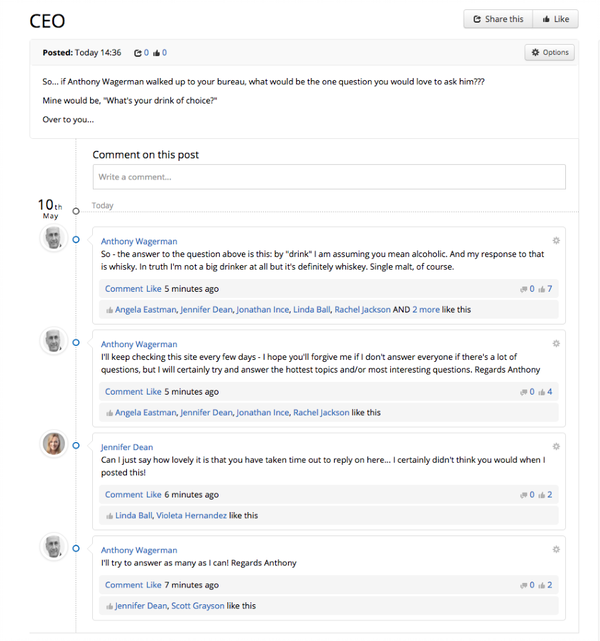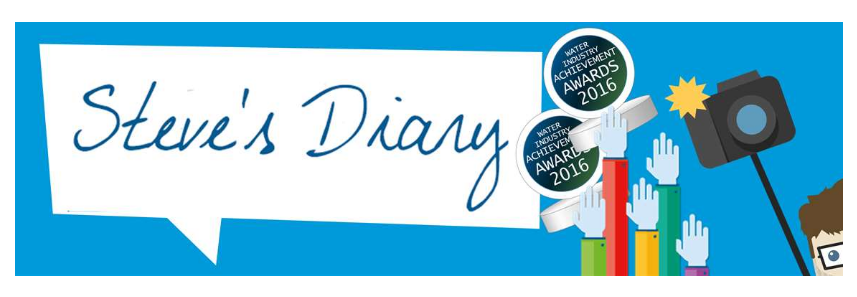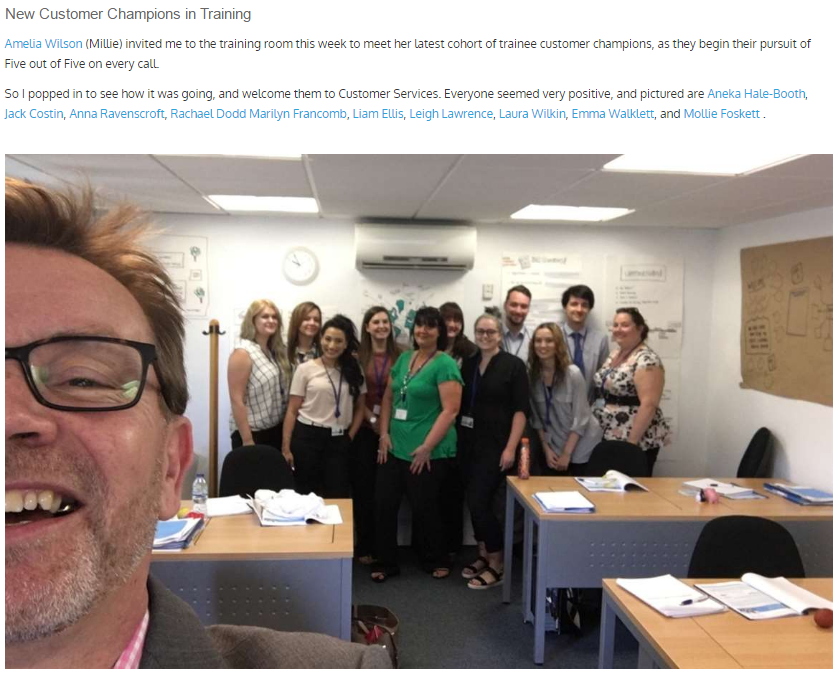Senior leadership plays a central role in defining the culture and direction of an organization, but for larger organizations in particular, they can often become elusive figureheads. How do you get your leaders in front of grassroots staff?


Those operating at the top table in an organization are a key driver of satisfaction for employees. Internal surveys and research repeatedly cite the relationship between senior management and staff as one of the biggest contributors to employee engagement levels and, in turn, business success.
However, keeping leaders front and center in a business has also never been more challenging.
We’re increasingly dispersed and globalized, with staff working remotely or scattered on the front-line: in stores, on the production line, out on the road. Face-to-face is being passed over in favor of email and IMing. Hierarchal glass ceilings are hard to break down and for many employees, the CEO is merely a name and a position – someone they may never meet, and certainly never speak to.
How can internal communicators break down the barriers and shift those at the top from figurehead, to human?
Why is leader comms and visibility important?
Leaders give an organization direction, purpose. They are crucial to keep staff in the loop about where the business is headed and how staff contribute to that vision, in recognizing success and motivating effort, in aligning efforts to the strategic direction of the organization. They are the guardian and reinforcer of the ‘big picture’.
Hearing from the boss makes a difference to how staff define purpose in their work – one of the increasingly important components of employee engagement, according to Gallup.
Leaders also serve a symbolic and reassuring role, particularly in times of change or uncertainty. Hearing from the captain navigating the ship reduces feelings of anxiety or discontent, protecting the business from associated implications such as low morale, staff turnover, or reduced productivity when negotiating rocky waters.
However, it’s also vital to get the communication between leaders and staff right. Deploying corporate-speak or hiding behind jargon is worse than no communication at all. The best leaders are:
- Authentic and personable
- Visible and approachable
- Open, transparent, and honest
The good news is, leaders and internal communicators now have a broad range of options for connecting management to staff. Here are our top tips for internal communicators to help get your leaders seen and heard.
#1: Use social tools to your advantage – and get creative
Much as we try and humanize our leaders, there’s always going to be an element of trepidation about chatting to the Big Boss.
Much of our workforce – and particularly the younger generations – default to digital forms of communication; embracing social technology as a channel to reach staff is a great way to engage workers who may not feel confident in a face-to-face scenario.
Encourage leaders to microblog using enterprise social networks, or even utilizing their own Twitter and LinkedIn: many employees will follow senior leaders on their professional social profiles. Is your leader attending an event, conference, visiting a customer or even one of your own sites? Why not get them ‘live tweeting’ – short but frequent updates to give grass-roots staff an insight into what’s happening? Or how about a one-off, ‘day in the life of’ each of your senior leaders via microblogging as a leadership comms series?

(Social channels are a powerful yet efficient way to communicate on a large scale. Your leaders will have a smartphone in their pocket – encourage them to use it!)
Alternatively, why not use your internal network to facilitate a virtual two-way town hall? Centrica, a British multinational energy services organization with around 30,000 employees, took this approach to connect front-line engineers and workers with the brand and its leaders. “YamJam” sessions are used as real-time Q&A sessions for employees to ask questions to senior management, including the Managing Director.
#2: Make it informal
There is a huge difference between having a leader stood on a platform or podium speaking down to a group of employees, and a leader sat with staff in the kitchen area sharing a pizza.
Informal environments are more likely to generate open conversations, instill trust, and enable employees to see the ‘real person’, rather than the managerial persona. Equally, an ‘open door’ leadership comms policy may be a good idea in theory, but in practice, few employees will feel comfortable or relaxed enough to walk into a senior management office and initiate a conversation (that’s if they’re fortunate enough to even have access to their leader’s office – not a privilege enjoyed by many dispersed employees).
44% of employees reported they do not feel free to speak their minds to their bosses
Consider adding a timetable of “Lunch’n’Learns” to your leadership comms plan, or ringfence a lunch/evening when your leaders go to visit different offices or sites for an informal “Meet the Boss – free lunch/drinks’ event.

These serve as a networking half-way point for senior leaders, rather than a full-on staff social – enabling them to meet and speak with different employees, get a feeling for the pulse of what’s happening in their organization, and providing a more approachable way to get conversations started.
#3: Small gestures make a big difference
For larger enterprises in particular, the reality is, no leader will physically be able to meet each and every employee. Logistically it may not be viable to even have leaders visit all regional offices or locations: when determining a strategy for leadership comms, we have to be realistic.
However, there is a great deal of power in leaders undertaking small, adhoc and personal efforts – and then telling the story on a wider scale.
As an example, Anthony Wagerman – CEO of international financial services provider Travelex, and winner of Best Stakeholder in the 2017 Intranet Excellence Awards – showed the power of simple, small gestures to increase his visibility and presence across the organization. Alongside his monthly vlog and weekly “Friday Night Updates” for the senior leadership team, Anthony takes an active role in responding to, and engaging with, employee blogs and forums across their company-wide intranet software, The Lounge.

This more personable and informal approach helps ‘humanize’ leaders, engages staff, and encourages your workforce to contribute content. With the comments and responses visible across the entire workforce on the intranet, even those not actively participating in the conversation can gain visibility of their leader.
Alternatives can include leaders microblogging or posting candid photos when visiting front-line staff, making a ‘surprise’ visit to a certain employee being recognized within the organization, or even simply liking the odd employee update. Perhaps one of the most powerful yet simple small gestures is for leaders to take the time to learn employee names. If you have a senior leader making a field visit, clue them up ahead of time with who they’re meeting on your People Directory. It’s a small gesture that makes a BIG difference.
#4: Match how your leaders communicate with the needs of your business
Every organization has a different culture, different demographic of staff, different channels available. In fact, a single organization itself will change from one year to the next. Continually evaluating how your staff are getting their information and what their preferences are for leadership comms is critical.
This is something we’ve come to understand firsthand at Interact, as we’ve undergone significant growth and international expansion.
When we were smaller as a business, the weekly “Friday Chat” was a great tool for connecting leadership to staff – a small town hall-style gathering, with a member of senior management on rotation to deliver key messages, updates, celebrate staff anniversaries, announce new starters and more. Staff could ask questions, feedback, and hear firsthand from those at the top. It formed a great part of the culture of the business and embedded the sense of community that defined ‘Interact’.

(Interact CEO Simon Dance delivering the Friday chat to the business).
As staff numbers grew, however, the Friday Chat became unfit for purpose.
Larger numbers standing the length of the office floor – which isn’t set up for group gatherings – meant not everyone could easily see the speaker and delivery was more difficult. The number of people in the audience also made it more difficult for individuals to speak up, ask questions, or contribute.
Time differences and tech challenges meant the NY and UK offices were getting news at different times and the pressure to have something ‘newsworthy’ to say each week resulted in ‘content for that sake of it’, rather than information that was actually relevant or useful to all employees.
We’ve recognized that as our company grows and evolves, the way we communicate has to also. Now, town hall gatherings are used for the big things – company-wide announcements or big updates, for example.
As an alternative, quarterly updates are now delivered by our CEO Simon to smaller groups of employees, usually made up of two or three departments, who will feel more comfortable speaking up in front of their peers. Having these less regularly makes for more relevant content, empowers employees to speak up, and helps each individual understand the ‘big picture’ and strategic direction of the business.
#5: Mix up media types
One of the biggest barriers to getting senior leaders to communicate is the age-old argument of time.
Our leaders are busy. They have a huge number of demands on their time and therefore a weekly 500-word intranet blog isn’t going to be ranking top on their list of priorities.
However, we now operate in an age of micro-blogging and Twitter; of Snapchat and Instagram, YouTube and Facebook live. Shorter and varied types of media are not only quick and easy to do, but also in high demand. Encourage senior management to mix it up and experiment with different media; it’s not only quick and easy to produce, but also easily digested by staff.
Our favorite example of this is Steve, Customer Service Director at South East Water. He had previously blogged weekly to a readership of around 30%+ of employees, but this was taking him between 1 – 2 hours each week. Switching to utilize the power of the selfie, Steve now takes a picture with the teams he meets and tags them in the picture with a short explanation. He saves valuable time, and readership has risen to above 60%.


(South East Water Customer Services Director, Steve George, uses his weekly diary to share updates from his area of the business, give recognition, and connect with staff.)
#6: Make the most of every piece of leadership comms
While time may be of the essence, communicators have the opportunity to step up and fill-in the gaps on this one.
To maximise visibility, you need to cater to a diverse range of needs and preferences. So why not deploy a content marketing approach, and maximize each piece of leadership comms you have?
Let’s say you have a town hall meeting or leadership update in the diary. For larger organizations in particular, it’s unlikely every employee will be able to attend – equally, different demographics will have differing preferences for how they access communications. Setting up a camera to video or livestream the event, recording the verbal update for an internal ‘podcast’, capturing photos for your intranet software, recycling presentation slides, or simply grabbing quotable extracts can help get the message seen and embedded across the organization. Why not follow up each event with a blog picking out the key messages or highlights?
Making senior leaders visible – in their own way
Traditionally, time pressures and varying communication skills have created a trend towards ghostwriting for leadership comms: having internal communicators, assistants, or middle management producing content in the name of senior leaders. But as the demand for authenticity continues to grow, we’re finding staff are less engaged with these more formal and impersonal approaches. They can sniff out fakes: they want the real deal, and it’s time to tell your boss about this need for authentic and effective comms.
91% of employees say communication issues can drag executives down, according to an Interact/Harris poll.
The role of internal comms should now be as facilitator, not creator. Empowering your leaders with the right channels and ideas for how to communicate effectively within the constraints of their role is far more effective and influential – and will secure buy-in from your staff. By playing a consultative role and connecting the needs of your staff with the capacity of your leaders, you can ensure every individual knows their boss.


